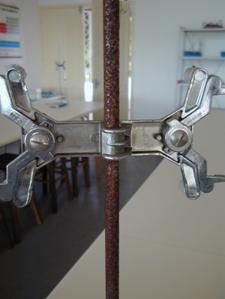Metals & Corrosion
Metals have a very important impact in the redox chemistry; that's why we ask attention for these elements now.
The real applications of the redox come later.


All metals are reductors (they have few valency electrons that can be donated), but not all of them in the same way.
On the contrary, Platinum and God are very weak, Calcium or Sodium are extremely strong.
Those very weak metals, in practice, do not really react; they are inert; the strong ones often can react heavily allready if they touch a bit of water.
Between these two extremes, the metals react more of less with acids.
In industrial areas you can notice sometimes some 'acid rain' when you look at metals and chalk in the neighbourhood.
Normally the metals must be protected against influences of water and acids, and we do so with paint, oil, etcetera. All to avoid corrosion.
The metals that do practically not react are the so called 'noble' and 'half noble metals.
Below find a redox table with metals:
Au3+ + 3e-  Au
Au
NO3- + 2H+ + e-  NO2 + H2O
NO2 + H2O
Ag+ + 1e-  Ag
Ag
Fe3+ + 1e-  Fe2+
Fe2+
Cu2+ + 2e-  Cu
Cu
Cu2+ + 1e-  Cu+
Cu+
SO42- + 2H+ + 2e-  SO32- + H2O
SO32- + H2O
Pb2+ + 2e-  Pb
Pb
Ni2+ + 2e-  Ni
Ni
PbSO4 + 2e-  Pb + SO42-
Pb + SO42-
Fe2+ + 2e-  Fe
Fe
Zn2+ + 2e-  Zn
Zn
2H2O + 2e-  H2 + 2OH-
H2 + 2OH-
Al3+ + 3e-  Al
Al
Mg2+ + 2e-  Mg
Mg
Al(OH)4- + 3e-  Al + 4OH-
Al + 4OH-
Na+ + 1e-  Na
Na
Ba2+ + 2e-  Ba
Ba
Ca2+ + 2e-  Ca
Ca
K+ + 1e-  K
K
Lets analyse this table:
In the column with oxidators you find the Gold ion, the stronguest oxydator with its conjugated reductor, the metal Gold, the weakest reductor.
In practice Gold has not the least tendency to react, to donate electrons. It is a noble metal.
Generally spoken, we may say that a reaction between reductor and oxydator will occur spontaneously when in this table the reductor has a position above th oxidator.
Than Silver will react with nitric acid, but not with sulfuric aced. And Calcium react spontaneously with water, but Iron does not.
Don't forget here that the table data count with standard temperatures of 20 à 25oC.
The position of a substance in these tables can change if the temperature changes.
General rule: to have a spontaneous redox reaction, the oxydator must be above the reductor.
In the table three non-metals are included, namely the three solutions/liquids: nitric acid, sulfuric acid and water.
We can notice that various metals can react in two ways: with or without auxiliary substances.
Example: Lead reacts much better in the presence of sulfate ions.
Gold and Silver react difficultly.

